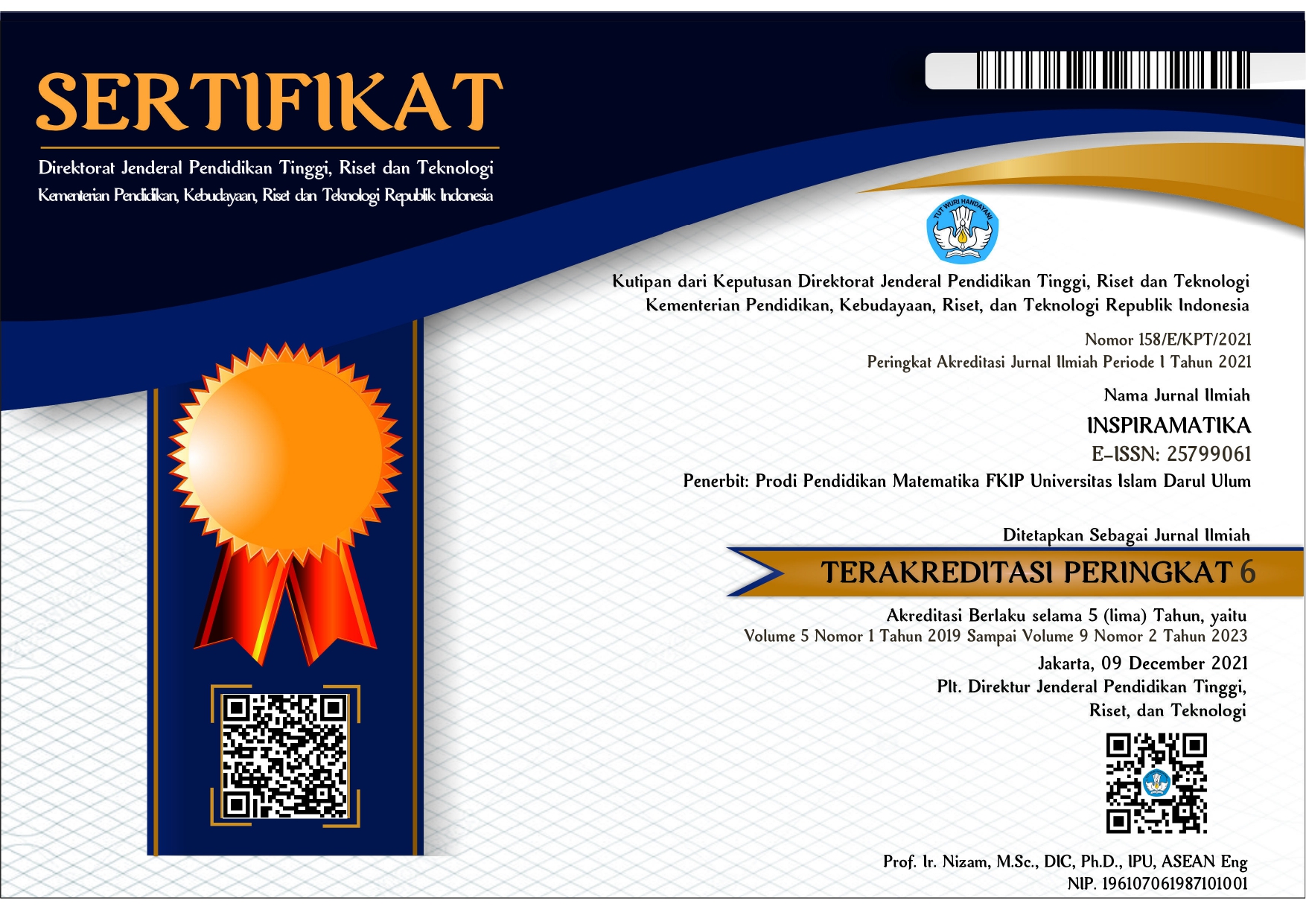KOMUNIKASI MATEMATIKA TERTULIS SISWA BERKEMAMPUAN MATEMATIKA RENDAH DALAM PEMECAHAN MASALAH SOAL HOTS BERDASARKAN JENIS KELAMIN
Abstract
This research aims to describe the written mathematics communication of students with low mathematical ability in solving HOTS problems based on gender. This research is a qualitative research because the main data about the accuracy, completeness, and fluency of written mathematics communication in the form of written words. The research subjects were 2 students with low mathematical ability in class XI MIPA MAN 1 Lamongan consisting of one male and female student. The results showed that there were slight differences in the written mathematics communication of male and female students in the fluency of the information conveyed.
Downloads
References
Asmana, A. T. (2018). Profil Komunikasi Matematika Tertulis dalam Pemecahan Masalah Matematika di SMP Ditinjau dari Kemampuan Matematika. INSPIRAMATIKA: Jurnal Inovasi Pendidikan dan Pembelajaran Matematika, 4(1), 1-12.
Caballero, A., Blanco, L. J., dan Guerrero, E. (2011). Problem solving and emotional education in initial primary teacher education. Eurasia Journal of Mathematics, Science andTechnology Education, 7(4), 281–292. https://doi.org/10.12973/ejmste/75206
Dewi, I. (2009). Profil Komunikasi Matematika Mahasiswa Calon Guru Ditinjau dari Perbedaan Jenis Kelamin. Disertasi tidak diterbitkan. Surabaya: PPs Universitas Negeri Surabaya.
Fanani, M. Z. (2018). Strategi Pengembangan Soal Higher Order Thinking Skill (HOTS) dalam Kurikulum 2013. Edudeena, 2(1), 57-56. https://jurnal.iainkediri.ac.id/index.php/edudeena/article/download/582/455
Gunawan, A. W. (2003). Genius Learning Strategy: Petunjuk Praktis untuk Menerapkan Accelerated Learning. Jakarta: Gramedia Pustaka Utama.
Hirschfeld-Cotton, K. (2008).Mathematical Communication, Conceptual Understanding, and Students' Attitudes Toward Mathematics. Action Research Projects (Paper 4). http://digitalcommons.unl.edu/cgi/vieviewcont.cgi?article=1011&context=mathmidactionresearch.
Isroil, A., Budayasa, I. K., dan Masriyah. (2017). Profil Berpikir Siswa SMP dalam Menyelesaikan Masalah Matematika Ditinjau dari Kemampuan Matematika. Jurnal Review Pembelajaran Matematika, 2(2), 93–105. http://jrpm.uinsby.ac.id/index.php/jrpm/article/download/34/31
Kemendikbud. (2017). Modul Penyusunan Soal Higher Order Thinking Skill (HOTS). Jakarta: Direktorat Pembinaan SMA Ditjen Pendidikan Dasar dan Menengah.
Kim, M. K., dan Noh, S. (2010). Alternative mathematics assessment: A case study of the development of descriptive problems for elementary school in Korea. Eurasia Journal of Mathematics, Science and Technology Education, 6(3), 173–186. http://www.ejmste.com/v6n3/eurasia_v6n3_kim.pdf
Lutfiyah, S. M., Kartinah, dan Rubowo, M. R. (2018). Profil Pemahaman Konsep Siswa Laki-laki dalam Pemecahan Masalah Matematika Menurut Tahapan Polya. Makalah disajikan pada Seminar Nasional Matematika dan Pendidikan (3th SENATIK), Semarang, 11 Agustus 2018. http://prosiding.upgris.ac.id/index.php/senatik2018/senatik18/paper/viewFile/2855/2682
NCTM. (2000). Principles and Standards for School Mathematics. School Science and Mathematics (Vol. 47). https://doi.org/10.1111/j.1949-8594.2001.tb17957.x
Nugroho, M., Setyawati, R. D., dan Sutrisno. (2018). Profil Kemampuan Siswa Laki-laki dalam Memecahkan Masalah Relasi Fungsi. Makalah disajikan pada Seminar Nasional Matematika dan Pendidikan (3th SENATIK), Semarang, 11 Agustus 2018. http://prosiding.upgris.ac.id/index.php/senatik2018/senatik18/paper/viewFile/2845/2672
Polya, G. (1973). How to Solve It. Princeton University Press (Vol. 30). https://doi.org/10.2307/3609122
Venkatesh Kumar, G. dan Karimi, A. (2010). Mathematics anxiety, mathematics performance and overall academic performance in high school students. Journal of the Indian Academy of Applied Psychology, 36(1), 147–150. http://search.ebscohost.com/login.aspx?direct=true&db=psyh&AN=2010-03566-016&site=ehost-live
Zhu, Z. (2007). Gender differences in mathematical problem solving patterns : A review of literature. International Education, 8(2), 187–203.
Zohar, A.dan Dori, Y.J. (2003). Higher order thinking skills and low achieving students: Are they mutually exclusive. The Journal of The Learning Sciences, 12(2),145-181.

This work is licensed under a Creative Commons Attribution-ShareAlike 4.0 International License.







.png)




